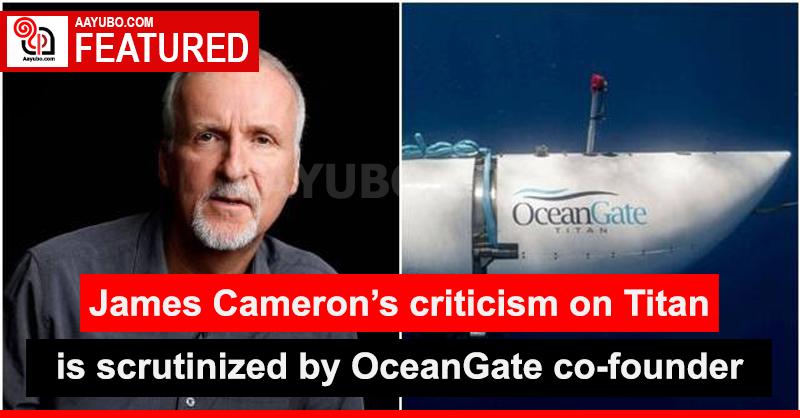James Cameron’s criticism on Titan is scrutinized by OceanGate co-founder

Guillermo Söhnlein, one of the co-founders of OceanGate, is defending his former company against criticism from James Cameron, the director of the movie "Titanic." Cameron criticized the design of OceanGate's tourist submersible called Titan, which collapsed and resulted in the death of all five passengers.
The submersible was exploring the wreck site of the Titanic when it went missing and lost contact with a research vessel on the surface. Cameron, well-known for his deep-sea dives and extensive visits to the Titanic wreck (more than 30 times), expressed his concerns about the submersible's carbon-fiber design, stating that it was too experimental to carry passengers and should have been certified. He has been sharing his worries about the lack of certification for such sea vehicles and advocating for stricter regulations on them through various news outlets.
In response to James Cameron's criticism, Guillermo Söhnlein, who co-founded the deep-sea tourism company in 2009, addressed the issue directly during an interview on the U.K.'s Times Radio. Söhnlein explained that within the diving community, there are different opinions and approaches regarding the design, engineering, construction, and operation of submersibles. He emphasized that neither he nor the other experts were involved in the design, engineering, building, testing, or diving of the subs, making it impossible for anyone to speculate accurately from an external perspective.
In another interview on BBC Radio 4's "Today," Söhnlein reiterated his defense and specifically mentioned James Cameron, highlighting that the film director was not present during the submersible's construction and its rigorous testing program.
He further explained that the program to develop this technology spanned 14 years and was highly robust, leading to successful scientific expeditions to the Titanic in recent years. He personally participated in the early stages of the program before the Titan submersible, and he emphasized that safety was of utmost importance, and the company had a strong focus on mitigating risks.
In an interview with CNN on Thursday evening, Cameron expressed his view that certification processes conducted by oversight groups like the American Bureau of Shipping or Norway-based DNV were crucial for ensuring diving safety. He criticized OceanGate, stating that it was unacceptable for the group not to undergo such a rigorous process, and he believed that the incident could have been avoided.
He explained that the situation revolves around the consequences of technology advancements surpassing regulations. He stated that those who develop technological innovations are often better positioned to understand the associated risks and find ways to minimize them effectively.
In the ABC News interview, Cameron mentioned that the diving community has had concerns about OceanGate's submersible for years. Prominent engineering figures within the community even wrote letters to the company expressing their worries. Cameron drew a comparison to the Titanic disaster in 1912, where the captain was repeatedly warned about ice ahead but chose to proceed at full speed on a moonless night, resulting in many deaths. He regarded the current incident as a similar tragedy, where warnings were disregarded. The fact that it occurred at the same location where diving activities take place worldwide was deemed astonishing and almost surreal by Cameron.
When communication with the submersible was lost, the U.S. Navy had actually detected the sound of it collapsing. However, this information was kept confidential while rescue and recovery efforts were ongoing for the following four days. The public only became aware of this detection when the Wall Street Journal reported on the event, which was later confirmed by The Times.
Interestingly, James Cameron claimed that he had prior knowledge of the "loud bang" detected by his sources within the close-knit submersible community. He informed Reuters that he had been notified about the sound and had already suspected that the submersible had collapsed. As early as Monday, Cameron had started emailing his colleagues, expressing that they had lost some friends and that the submersible was currently in pieces at the bottom.
As investigations continue to identify the precise reason for the submersible's collapse, James Cameron has consistently highlighted the role of the Titan's carbon-fiber composite hull as a probable factor in its demise. During an interview on "Good Morning America," the director of "Avatar" explained that composites are unsuitable for vessels subjected to external pressure, such as deep-sea diving. While they work well for internal-pressure structures like scuba tanks, they are ill-suited to withstand external pressure. Cameron characterized the situation as an attempt to apply principles from aviation to the engineering challenges of deep-sea submersibles.
However, Rush, one of the co-founders of OceanGate, had a different perspective. He believed that the use of carbon-fiber material, commonly employed in the aerospace industry, would drive deep-sea research and advance his company. This new material enabled the design of sea vehicles with larger hulls, providing scientists with more operational space or accommodating more enthusiastic passengers for tourism purposes.
Rush recognized that research ventures could be costly and aimed to offset these expenses through high-end adventure tourism, such as offering dives to the Titanic wreck site with the Titan submersible. Additionally, he sought collaborations with other industries like oil and gas, utilizing the technology for mapping the sea floor in search of excavation sites, as well as inspecting bridges or ship hulls.
In a 2017 interview with Fast Company, Rush emphasized that the commercial side held long-term value. He saw adventure tourism as a means to generate revenue while also proving the capabilities of the technology.
The source of the story: Los Angeles Times
780 Views


Comments